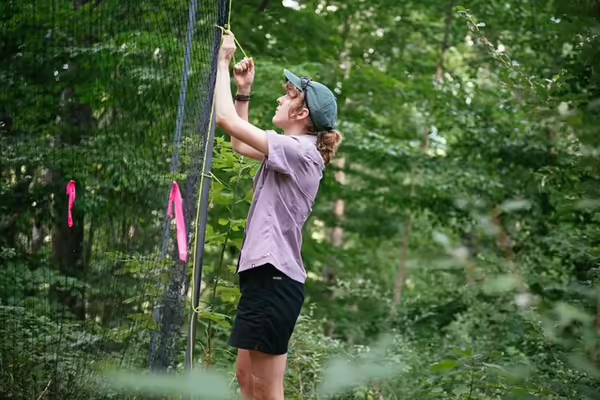
URBANA, Ill. – Bats help keep forests growing. Without bats to hold their populations in check, insects that munch on tree seedlings go wild, doing three to nine times more damage than when bats are on the scene. That’s according to a groundbreaking new study from the University of Illinois.
“A lot of folks associate bats with caves. But as it turns out, the habitat you could really associate with almost every bat species in North America is forest. And this is true globally. Forests are just really important to bats,” says Joy O’Keefe, study co-author and assistant professor and wildlife extension specialist in the Department of Natural Resources and Environmental Sciences at Illinois. “We wanted to ask the question: Are bats important to forests? And in this study, we've demonstrated they are.”
Other researchers have demonstrated bats’ insect-control services in crop fields and tropical forest systems, but no one has shown their benefits in temperate forests until now.
“It's especially important for us to learn how bats affect forests, given that bats are declining due to diseases like white-nose syndrome or collisions with wind turbines. This type of work can reveal the long-term consequences of bat declines,” says Elizabeth Beilke, postdoctoral researcher and lead author on the study.
Overall, the researchers found three times as many insects and five times more defoliation on the seedlings when bats were excluded than in control plots that allowed bats in each night. When analyzed separately, oaks experienced nine times more defoliation and hickories three times more without bats.
While insect pressure was intense in plots without bat predation, the seedlings didn’t succumb to their injuries. But the researchers say long-term bat declines could prove fatal for the baby trees.
The article, “Bats reduce insect density and defoliation in temperate forests: an exclusion experiment,” is published in Ecology [DOI: 10.1002/ecy.3903]. The research was supported by USDA’s National Institute of Food and Agriculture, the Indiana State Department of Natural Resources, the Indiana Space Grant Consortium, the Department of Biology at Indiana State University, and the Department of Natural Resources and Environmental Sciences at Illinois.
Read more from the College of ACES
The Department of Natural Resources and Environmental Sciences is in the College of Agricultural, Consumer and Environmental Sciences at the University of Illinois Urbana-Champaign.